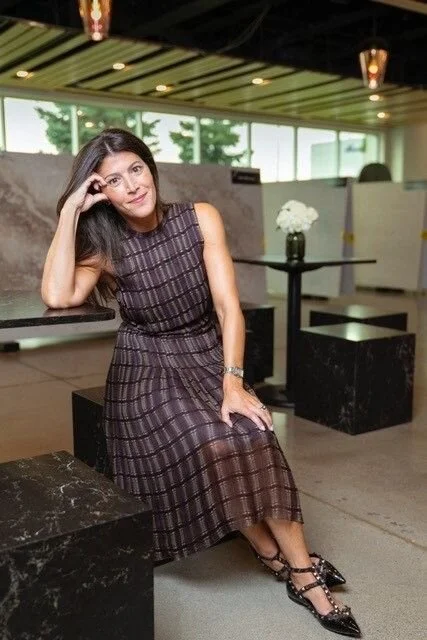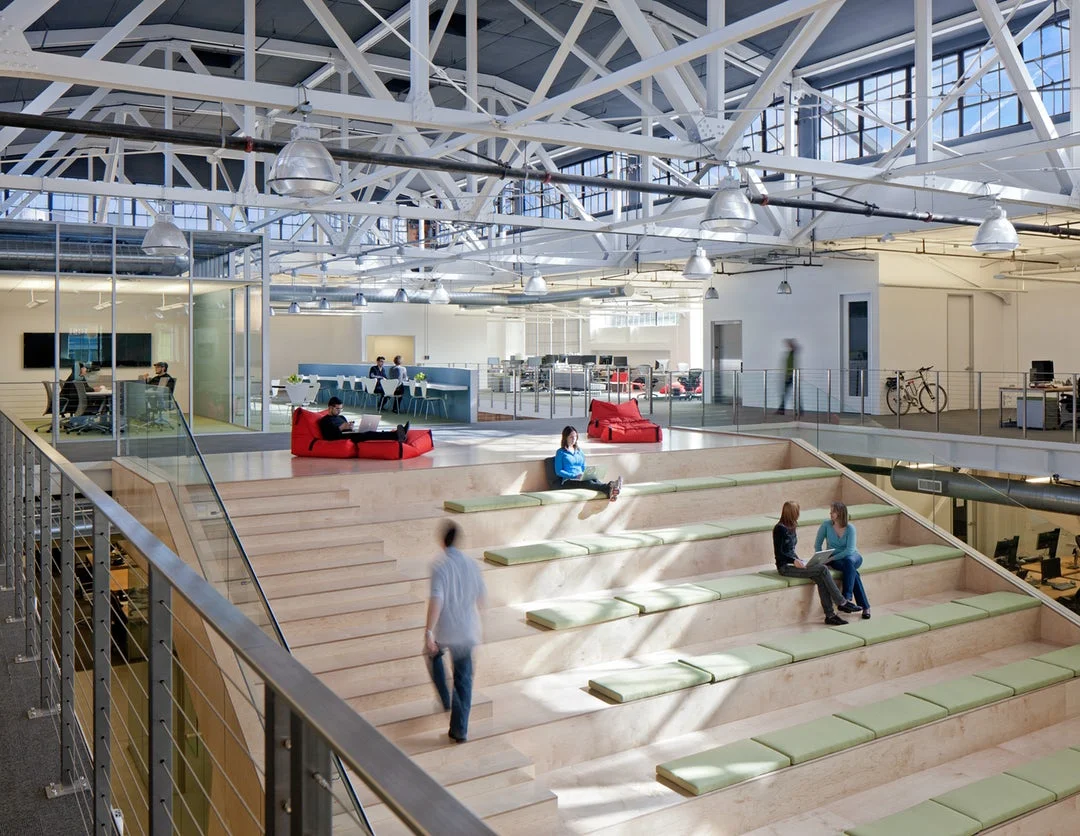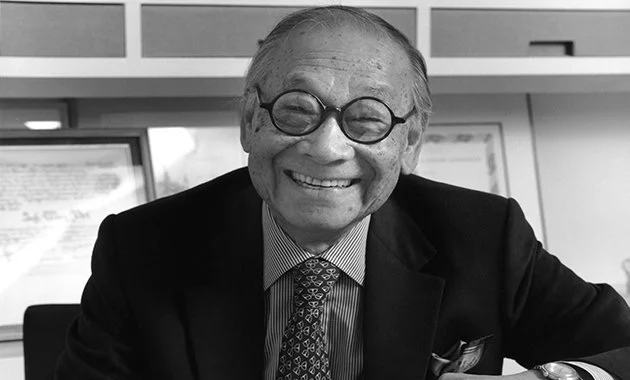Design contracts and new project inquiries reached their highest point in May, and have stayed in positive territory every month in 2017.
"Apple's new campus sucks" according to Wired magazine
"By building a mega-headquarters straight out of the middle of the last century, Apple has exacerbated the already serious problems endemic to 21st-century suburbs like Cupertino – transportation, housing, and economics."
Frank Lloyd Wright designed the Johnson Wax offices as a forest open to the sky
Mushroom-shaped columns, pyrex skylights and earthy coloured furnishings feature in Frank Lloyd Wright's Johnson Wax Headquarters, which is next in our series of the architect's most important projects, celebrating the 150th anniversary of his birth last week.
Nendo Takes On Architecture With A Huge New Public Plaza (And A Trampoline, Of Course)
The Japanese designer Oki Sato is known for producing a tremendous amount of work each year—from design objects to lifestyle products to exhibitions—through his design studio, Nendo. Now, Sato and his 30- person team are increasing not only the quantity, but also the scale of their work. In its first foray into urban planning, Nendo has designed a massive public plaza near Kyoto, with a stage, park, bike rental station, and jungle gym housed in a series of stepped saucers reassembling local topography.
Yesterday's urban factory could be tomorrow's tech HQ
Midcentury facilities designed for once-humming industries are finding new leases on life through adaptive reuse, as architects reanimate these aging relics into tech offices, loft-style residences, and even art institutions. In San Francisco, the Pinterest headquarters is a striking example of the potential for modernizing a former factory in a post-industrial age. Designed by the team of IwamotoScott Architecture with Brereton Architects, the Pinterest HQ revitalizes a former John Deere factory in the city’s South of Market district—which itself has seen transitions from Gold Rush boomtown to today’s tech hub, and also boasts adaptive reuse offices for companies such as Twitter and LinkedIn.
Factors to Consider In Selecting an Urban or Suburban Corporate Campus
Since their debut in the 1950s, suburban corporate campuses have come to symbolize the culture and success of U.S. enterprise. But could the era of the suburban corporate campus be nearing its end?
MoMA Unveils Completed Renovation and Detailed Plans for Expansion
Thursday, New York’s Museum of Modern Art (MoMA) revealed the completed renovation of the east end of its campus, anchored by its original 1939 Philip Goodwin/Edward Durell Stone structure, now called the Lauder Building.
Tech Titans' Glitzy Digs Don't Always Pan Out
Not every trophy campus is a monument to a company's success. In fact, it can have just the opposite effect, reflecting a sour turn in fortunes.
Architecture Billings Ease in April, but Remain in Positive Territory
The monthly Architecture Billings Index (ABI) came in at a score of 50.9 in April, down 3.4 points from March's 54.3, the AIA announced today.
Functional Flexibility: 7 Terraced Staircases Imagined for Communal Gathering
Have you ever been called to a meeting room only to arrive in an underwhelming cube, where you immediately begin to shuffle chairs around like bumper cars? And after all that kerfuffle, there still remains one isolated worker standing in the corner, without a car of their own to park around the table. While not disastrous on any scale, these repetitive and sometimes awkward encounters are avoidable, and largely delineated by an unsuitably executed built environment. Such situations — whether similarly inconsequential or more cataclysmic — are simple indications that good architectural and design interventions, are essential in our everyday work environments.
Look Up: Celebrate the Ceiling
For centuries, ceilings have served as a focal point and source of inspiration. Whether it’s the vaulted ceiling of New York’s Grand Central Terminal or the sheer artistry of the Sistine Chapel, the “fifth wall” has played a central role in enhancing buildings and inspiring their occupants.
ONE MORE THING INSIDE APPLE’S INSANELY GREAT (OR JUST INSANE) NEW MOTHERSHIP
ON JUNE 7, 2011, a local businessman addressed a meeting of the Cupertino City Council. He had not been on the agenda, but his presence wasn’t a total surprise. Earlier in the year the man had expressed his intention to attend a meeting in order to propose a new series of buildings along the city’s northern border, but he hadn’t felt up to it at the time. He was, as all of them knew, in dire health.
Wellness design is spreading across hospitality architecture and beyond
Fifty years ago, the term wellness—if it was used at all—essentially meant “not sick.” Then, throughout the ’80s and ’90s, the rise of gym culture and workplace wellness
snowballed into an explosion of fitness boutiques in the early aughts. In city centers and upscale suburbs today, specialized fitness boutiques such as SoulCycle, PureBarre, Barry’s Bootcamp, and FlyWheel are nearly as ubiquitous as Starbucks. Combined with the rapid expansion of “health” branded grocery stores, an uptick in haute athletic wear, and a plethora of juice and smoothie companies, not to mention the surrounding media buzz, wellness has become not so much a trend as a booming industry.
Architects Stanley Tigerman and Margaret McCurry retiring
Legendary Chicago architects Stanley Tigerman and Margaret McCurry of Tigerman McCurry Architects are closing their Chicago office and tell Dennis Rodkin at Crain’s Chicago Business that they are retiring. The pair, which have long been prominent figures in Chicago’s architecture scene, say that they will make a formal announcement in the coming weeks.
Eppstein Uhen Architects Acquires Burkettdesign
Milwaukee-based Eppstein Uhen Architects (EUA) is acquiring Denver-based architecture and interior design firm Burkettdesign. With more than 180 employees across three offices in Wisconsin and Iowa, EUA will be joined by the 27 employees of Burkettdesign’s Denver office, which will change its name to BurkettEUA.
Shuttleworth: ‘Foster’s Bloomberg building will be a standout office of this generation’
Make Architects founder and president of the British Council of Offices (BCO), Ken Shuttleworth, talks about the future of workplace design ahead of this year’s BCO conference in London.
How to Become a Billionaire: Startups for Architects
Back in 2008, there was an architect in Brooklyn who was bored with his job. Wandering around his office building, he befriended a failing entrepreneur who was trying to start a baby clothing company. The two decided to take a shot at something new and opened a co-working space on a vacant floor of their building. Nine years later, the two own one of the world’s most valuable startups, WeWork, valued at around $17 billion. It’s worth nearly as much as AECOM, the world’s largest architecture firm, and they have raised more than $1 billion in startup capital without going public, making it, in the parlance of Silicon Valley, a unicorn. It’s the tech equivalent of winning a Pritzker Prize.
Michelle Obama took the stage at the American Institute of Architects 2017 Conference
To say the air was electric before Michelle Obama took the stage at the American Institute of Architects 2017 conference would be an understatement. Thousands lined up more than an hour early at the doors of the auditorium in Orlando’s Orange County Convention Center. Some sported “When they go low, we go high,” t-shirts. Even AIA president, Thomas Vonier, was giddy. “This is really happening,” he told a packed house of more than 10,000 architects.
The former first lady of the United States, in her first public appearance since leaving the White House in January, was more pragmatic. She told Vonier, “It’s good to get out of the house.”
2017 AIA Conference: Architects Talk Socially Conscious Design
“The making of architecture is best taught by example,” said Robert A. M. Stern today, as he accepted the 2017 AIA Topaz Medallion at the national conference in Orlando. “Architecture education should also prepare students to positively affect the lives of others.”
Master Architect I.M. Pei Celebrates His 100th Birthday
Happy Birthday to one of the most accomplished architects of our time!
Born in Guangzhou, China on April 26, 1917, Ieoh Ming Pei moved to the United States to study architecture and later began his career in New York where he still lives today. "New York," realized I.M. Pei, "is the most exciting city in the world, it pulsates with life."

























